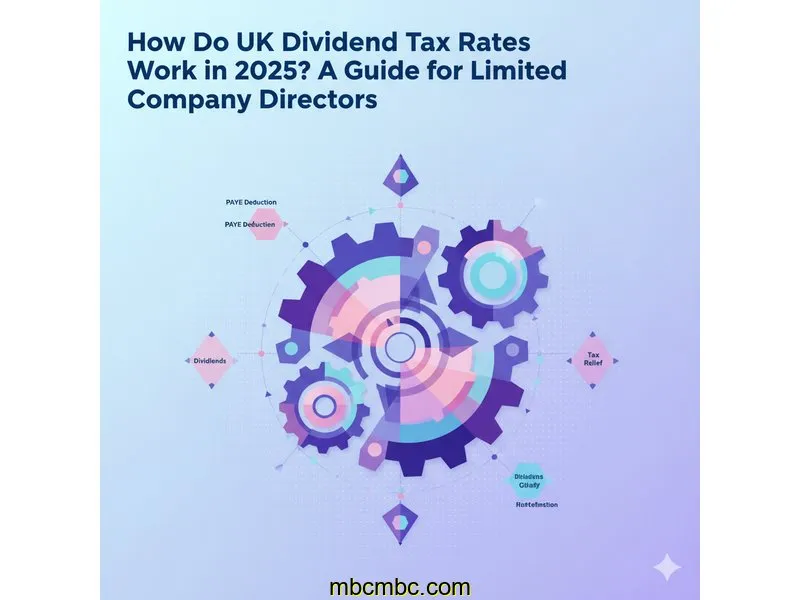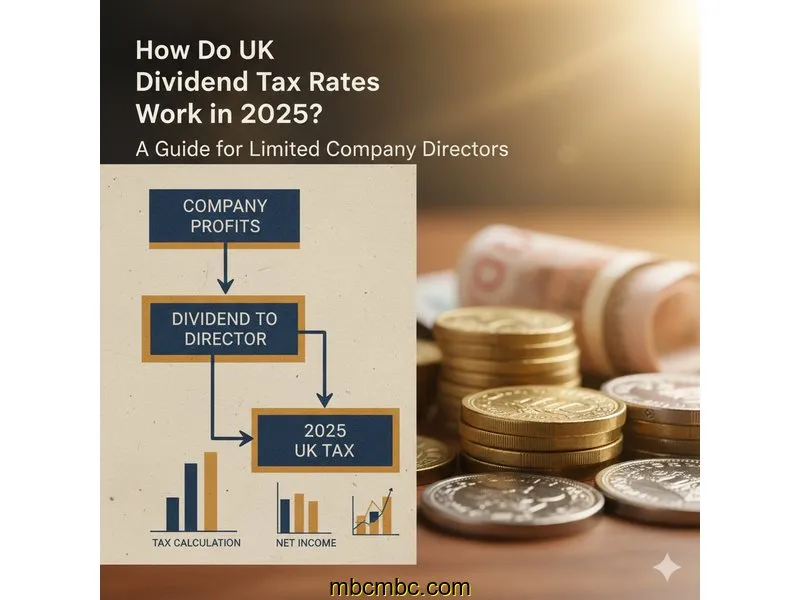
As a limited company director in the UK, you've likely heard endless discussions about the "most tax-efficient" way to pay yourself. This almost always involves a mix of a small salary and larger dividend payments. While this strategy is common, understanding how the tax on those dividends *actually* works is crucial, especially as the rules and allowances have tightened.
Many directors are clear on their salary (which is handled by PAYE) but get a surprise when their first Self-Assessment tax bill arrives, detailing the dividend tax owed. The rates are different from income tax, the allowances work in a unique way, and it's all calculated based on your *total* income for the year. My name is Alex Williams, and as the developer behind FinTools UK, I've seen this confusion firsthand. This guide aims to demystify the process, breaking down the 2024/2025 dividend tax rates, the all-important (and shrinking) Dividend Allowance, and how to figure out what you'll actually owe.
This article is for informational purposes only. It's designed to help you understand the mechanics, not to provide financial advice. For decisions specific to your company and personal finances, consulting with a qualified accountant is always the best path.
Quick Summary: Dividend Tax in 2024/2025
- What it is: A tax paid on dividend income you receive, typically from shares in your own limited company.
- Key 2024/25 Rates: 8.75% (Basic Rate), 33.75% (Higher Rate), and 39.35% (Additional Rate).
- The Dividend Allowance: For the 2024/25 tax year (6 April 2024 to 5 April 2025), you get a £500 Dividend Allowance. This means the first £500 of your dividends are taxed at 0%.
- How It's Paid: Dividend tax is NOT deducted at source. You must declare your dividend income on your annual Self-Assessment tax return, and the tax is paid as part of your final bill.
- Key Principle: Your dividend income "sits on top" of your other income (like your director's salary) to determine which tax band it falls into.
What's a Dividend (and Why Is It Taxed Differently)?
First, let's clarify the difference between the two ways you typically get paid as a director:
- A Director's Salary: This is a payment for your work as an employee. The company treats this as a business expense, which reduces its Corporation Tax bill. This salary is subject to PAYE (Pay As You Earn) Income Tax and National Insurance contributions, just like any other employee.
- A Dividend: This is a payment of company profits *after* the company has already paid (or is due to pay) Corporation Tax. Because the company has already been taxed on this money, the personal tax you pay on it (dividend tax) is different. Crucially, dividends are not subject to National Insurance, which is a key reason they are a tax-efficient way to extract profit.
Think of it this way: your salary is your 'wage' for running the business day-to-day. Your dividends are your 'reward' as an owner for the company's success, taken from the profits it has *already* been taxed on.
The UK Dividend Tax Rates (2024/2025)
The rate of tax you pay on your dividends depends on your *total* income, which places you into an Income Tax band. Your dividend income is added on top of your salary and any other income to see which band it falls into.
Here are the rates for the 2024/2025 tax year, after you've used your £12,570 Personal Allowance and £500 Dividend Allowance:
| Tax Band | Total Income Threshold (2024/25) | Tax Rate on Dividends |
|---|---|---|
| Basic Rate | £12,571 to £50,270 | 8.75% |
| Higher Rate | £50,271 to £125,140 | 33.75% |
| Additional Rate | Over £125,140 | 39.35% |
The £500 Dividend Allowance: The Big Pitfall
This is the single biggest point of confusion and the most important recent change. For the 2024/2025 tax year, the **Dividend Allowance is just £500**.
This allowance has been reduced sharply by the government, down from £1,000 in 2023/24 and £2,000 in the years before that. This means more directors are paying more dividend tax than they used to, even if their income hasn't changed.
Here's how it works:
- It is not an extra tax-free allowance. It's a 0% tax rate on the first £500 of your dividends.
- It does use up part of your tax band. For example, if you are a basic rate taxpayer, your £500 allowance uses up the first £500 of your basic rate band.
- Everyone gets it, regardless of their tax band.
A Practical Scenario: Calculating Your Tax

Let's walk through a common director scenario to see how this fits together. All figures are for the 2024/25 tax year.
Scenario: You are a director. You pay yourself a salary of £12,570 (to use your full Personal Allowance without paying NI) and take £40,000 in dividends. You have no other income.
- Salary: Your £12,570 salary uses up your entire £12,570 Personal Allowance. Tax on salary = £0.
- Total Income: Your total income for tax purposes is £12,570 + £40,000 = £52,570.
- Dividend Allowance: The first £500 of your £40,000 dividend is covered by the 0% Dividend Allowance. Tax = £0.
- Remaining Dividends: You have £39,500 of dividends left to tax (£40,000 - £500).
- Tax Bands:
- Your salary used up the band up to £12,570.
- The Basic Rate band ends at £50,270.
- The amount of your dividend that falls in the Basic Rate band is £50,270 - £12,570 = £37,700.
- Your £500 0% allowance used the first £500 of this.
- So, the next £37,200 of dividends (£37,700 - £500) are taxed at the Basic Rate of 8.75%.
- Tax = £37,200 x 8.75% = £3,255.
- Higher Rate Tax:
- Your total income is £52,570, which is over the £50,270 Higher Rate threshold.
- The amount of income in the Higher Rate band is £52,570 - £50,270 = £2,300.
- This £2,300 is all from your dividends, so it's taxed at the Higher Rate for dividends: 33.75%.
- Tax = £2,300 x 33.75% = £776.25.
- Total Tax Bill: Your total dividend tax bill for the year, which you will pay via Self-Assessment, is £3,255 + £776.25 = £4,031.25.
How Calculators Help Understand Dividend Tax
As you can see from the example, the calculation isn't simple. It depends on how your salary, allowances, and dividends all interact with the tax bands. This is where a good dividend tax calculator becomes incredibly useful.
Instead of doing this complex maths manually, a calculator allows you to model different scenarios. You can quickly see the tax impact of:
- Taking a £9,100 salary vs. a £12,570 salary.
- Taking £30,000 in dividends vs. £50,000.
- Seeing exactly how much of your dividend income will be pushed into the higher rate band.
Using a tool can help you plan your dividend payments throughout the year and, most importantly, set aside the correct amount of money for your Self-Assessment tax bill so there are no surprises in January.
Common Questions About Dividend Tax for Directors
This topic generates a lot of specific, practical questions. Here are answers to three of the most common ones I've seen.
Is the £500 Dividend Allowance separate from my Personal Allowance?
Yes, they are two different things. The Personal Allowance (£12,570) is your main tax-free allowance that applies to your total income (salary, interest, etc.). The Dividend Allowance is a separate, specific 0% tax band for the first £500 of your dividend income. You get both, and your Personal Allowance is always used first.
How do I actually pay the dividend tax I owe?
Unlike your salary, tax is not deducted automatically. You must complete a Self-Assessment tax return each year. On this return, you declare all your income, including your director's salary and all the dividends you received. HMRC's system then calculates your total tax liability, including the dividend tax, which you must pay by the 31st of January following the end of the tax year.
What's the difference between a dividend and a director's salary again?
A salary is a business expense and is paid *before* Corporation Tax; it is subject to Income Tax and National Insurance. A dividend is a distribution of profit and is paid *after* Corporation Tax; it is subject to Dividend Tax but not National Insurance. This lack of NI is the primary reason the salary/dividend mix is so popular for directors.
Conclusion: Planning is Key
Understanding how dividend tax works is a vital part of running a limited company. The key takeaways for the 2024/2025 tax year are the rates (8.75%, 33.75%, 39.35%), the fact that dividends are taxed based on your total income, and the very small £500 Dividend Allowance. This reduced allowance means that planning and budgeting for your tax bill are more important than ever.
While tools and guides can help you understand the mechanics, this information is not a substitute for professional, tailored advice. The optimal way to pay yourself depends on your company's profits, your personal financial situation, and your future goals. An accountant can provide specific guidance to help you navigate these rules correctly.

